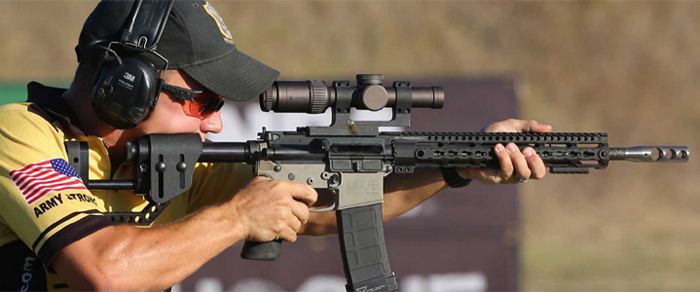Hmmm,
Opinionated jerk here, so take it with a grain of salt:
You are not raising the scope, you are lowering the rifle.
Stay with me here:
If you view pics of Olympic shooters, they try to keep the eyes level in all their shooting positions. Level eyes (visual cues) and level ears (balance control) translates to the ultimate in steady aiming.
If you study their gear, most are running sights on tall blocks, and often they are canted over to align with the shooters level eyes (gun to shooter, not shooter to gun.)
Look at silhouette shooters, which went crazy with ladder mounts-scopes jacked way up and rifle lower to the shoulder, again all about balance with level eyes/head.
Now we have the barricade rifle/shooter system. Viewed from the side, the sighting system, grip, foreward support, and buttplate. The shooter’s eye, grip/trigger finger, support elbows, and shoulder.
If the barrel/trigger is the fixed point in space- aiming at the target, then the first variable is the height the bore is above ground (for now I’m discussing aiming at a target the same elevation as the barreled action).
Since the human element comes in such a variety of shapes and sizes, the rifle cannot be a “one size fits all”.
Likewise, and what I think doesn’t get enough consideration:
The height the rifle has to be above ground (obviously supported by the shooter) dramatically impacts the angles the shooter’s body is in, as well as the best “form” the rifle should take to yield the best shot.
Look at it another way-
The most comfortable shooting position is from a bench. The rifles weight is fully supported- fixed in space. Now you build your position behind the rifle with grip, shoulder, cheek. If the bench and rifle is too low, you are hunched over. Now your eye is closer to the scope, so you drag your face back, kink your neck, who knows with the length of pull whether the buttplate is even touching your shoulder pocket, is beneath it, or dead pressed in so hard it’s ridiculous. So- rifle and bench height are important, but so are the rifle adjustments.
If the rifle can not be moved, now you have to rely on adjusting what you can to make it interface/ fit your body properly for the best results. That’s just from a frikken bench!
You start prone, ok- what is your optimal shoulder height above ground level?
What height and angle is your head to give the most comfort, but also the clearest vision (yes, the angle your eyes are looking out of your skull effects your vision/clarity/and amount of induced strain.)
Think of your shoulder and eyes as the fixed points in space: Now the cheekpiece and buttplate must be adjusted to fit this ideal.
What distance from your shoulder places your grip/trigger hand at it’s optimum for both elbow angle and support, but also grip control AND trigger control. Wait,(that hand) it’s also pulling the rifle into your shoulder as well.
Throughout rifle design the grip has largely been an afterthought, yet it controls EVERYTHING!
Sooo much to consider…
Now, if you are not going to reset your rifle adjustments for each different position, then one logic would be to lock it into an “average” so while it would never shine in any position, it won’t absolutely suck in one particular position. Ok, what if you adjust it to best fit your worst/most unsteady position, and then let your body compensate for the rest?
No, I don’t have all the answers, but I do have a boatload of questions






